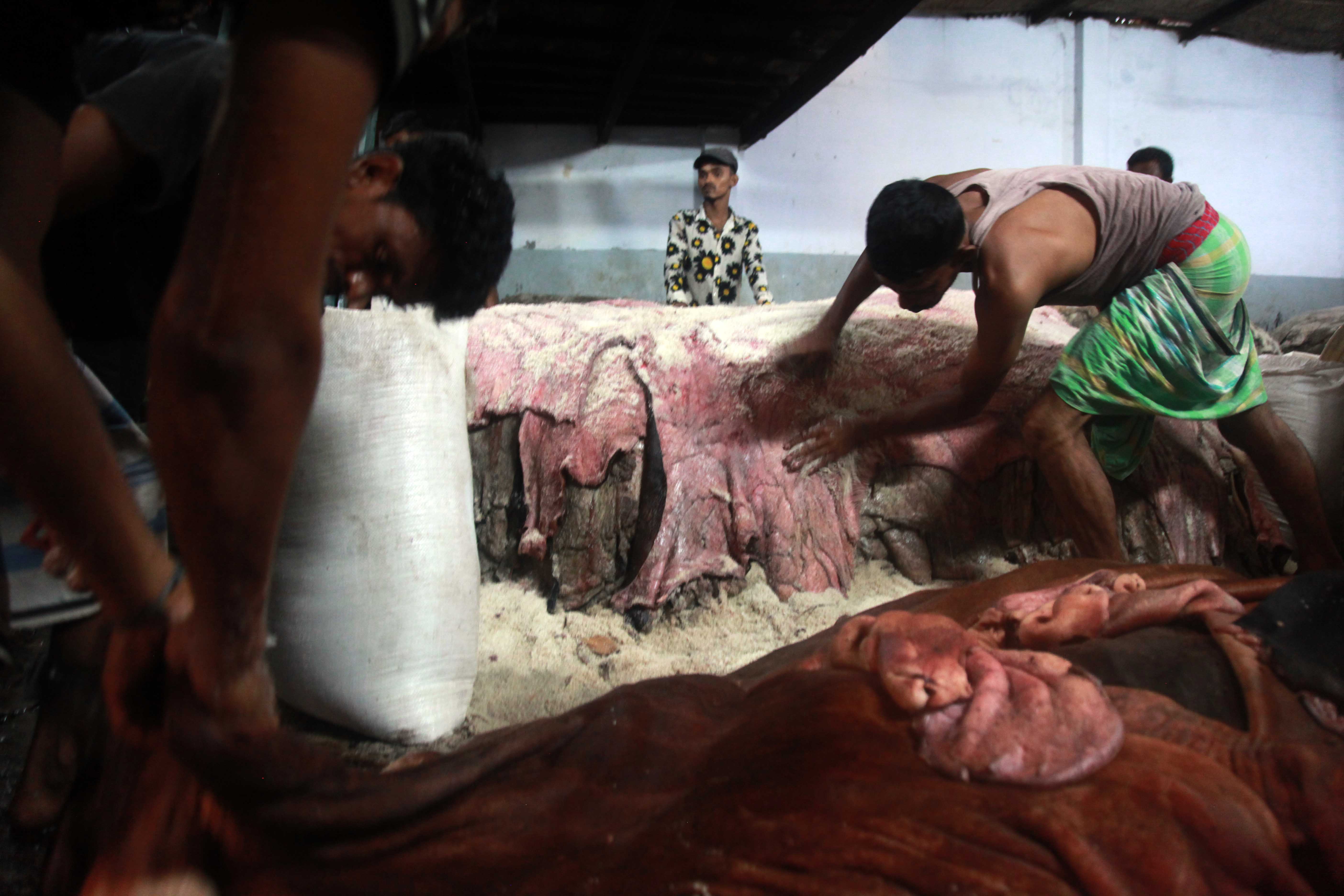Rawhide traders cry foul amidst leather's export slump

Salted rawhides are stacked in Posta. Photo Credit: Nazmul Islam
The bustling animal hide market in Posta, Dhaka, was once again in full swing as Eid-ul-Adha drew to a close. However, this year's trade tells a story of contrasting fortunes for different players in the market.
Wholesalers and tannery owners report a slight increase in hide prices compared to last year, paying an additional Tk 150 to Tk 200 per hide.
This news however brings a glimmer of hope for only those at the top of the supply chain.
For seasonal traders and brokers, the reality is far less rosy. They lament that the price of hides remains stubbornly low, mirroring last year's rates. Even those who made the sacrifices are feeling the pinch, unable to secure better deals for their valuable hides.

"It's the same old story," Ashraful Haque, one seasoned hide trader remarked, shaking his head. "The big players make their profits, while we're left struggling to make ends meet."
Price differentials for different traders
This year's rawhide trade in Posta has witnessed a significant price hike for buyers, according to trader Rafiqul Islam.
Speaking to Bangla Outlook, Rafiqul revealed that he is paying Tk 150 to Tk 200 more per hide compared to last year. This means a hide previously priced at Tk 800 now costs him Tk 1000.
The scene at Posta is a mix of anticipation and frustration. Vans laden with hides line the streets, their owners hoping for a lucrative sale.
Sellers voice their disappointment, citing the disparity between what they're offered and their expectations, with many asking for Tk 1200 to Tk 1500 taka for larger hides, while buyers, like a shoe company representative Robiul Alam, are only willing to pay Tk 800 to Tk 900.
Robiul explains that the subdued export market has forced his company to focus solely on domestic shoe production, limiting their spending power.
Even though buyers like Robiul are paying more per hide this year, the increase hasn't translated into higher profits for sellers like Abdul Gani, a madrasa teacher who came to Posta with a car full of hides, hoping for a better return.
“They are offering me such a low price that I have decided to take back my hides,” said Abdul.

In Dhaka, the government has set the price for salted cowhide at Tk 55-60 per square foot, a Tk 5 increase from last year. Outside the capital, the price is set at Tk 50-55, a maximum increase of Tk 7 compared to last year.
Prices for salted goat and buck hides have also been fixed at Tk 20-25 and Tk 18-20 respectively.
A medium-sized hide of 25 square feet was expected to fetch Tk 1375 to Tk 1500 in Dhaka, but after deducting costs for salt, labor, and other expenses, the estimated price drops to Tk 1125 to Tk 1250.
Traders say this year's prices are still a far cry from the peak in 2013 when cowhide fetched Tk 85-90 per square foot. Since then, prices have steadily declined due to various factors.
Declining price marks a declining export trend
The demand for raw hides has been on a downward trend since 2017, causing difficulties for those who sacrificed animals in both Dhaka and other parts of the country.
One of the major reasons behind the declining price of raw hides is the declining export of leather.
The leather export industry has been facing a multitude of challenges, contributing to a significant decline over the past decade.
The relocation of tanneries from Hazaribagh to Savar in 2017, coupled with the devastating impact of the Covid-19 pandemic and the Russia-Ukraine war, have all played a role in this downturn.

Data from the Export Promotion Bureau (EPB) reveals that leather exports have been cut by more than half in the last ten years.
In the fiscal year 2022-23, exports amounted to a mere $123.44 million, a sharp contrast to the $397.54 million recorded in FY14. The downward trend persisted into the July-May period of the outgoing fiscal year, with exports reaching only $125.72 million.
Leather and leather goods exports consistently exceeded $1 billion annually for a decade, peaking at $1.13 billion in FY15. However, this trend reversed in FY23, with exports falling to $961.49 million.
Reasons behind declining export
According to Md Saiful Islam, former president of the Leathergoods and Footwear Manufacturers & Exporters Association of Bangladesh, leather once dominated the export landscape, accounting for over 75% of total leather and leather goods exports 25 years ago.
However, this share has dwindled to a mere 13%, signaling a shift towards increased local value addition.
Despite this progress, Saiful points out that the leather sector still faces significant challenges.
He attributes lower export volumes and depressed prices to poor adherence to environmental standards in tanneries and the Savar tannery estate, further emphasizing the need for greater sustainability in the industry.

Md Shakawat Ullah, general secretary of Bangladesh Tanners Association (BTA), shares the same concern over the challenges faced by local leather exporters.
He told Bangla Outlook that poor compliance with environmental standards at the Savar Tannery Industrial Estate (STIE) has prevented tanneries from obtaining the crucial Leather Working Group (LWG) certification, hindering their access to major international markets in Europe and North America.
Consequently, local exporters are forced to rely on China as their primary market, despite receiving prices nearly 60% lower than international standards.
This dependence on a single market with lower prices has a significant impact on the overall profitability and growth of the industry, said Shakawat.
–

